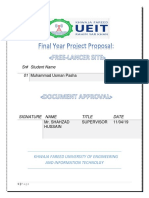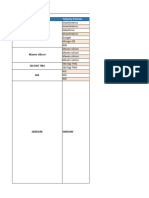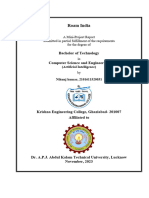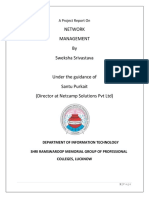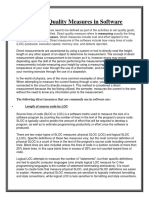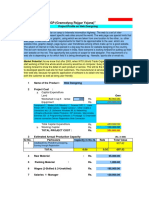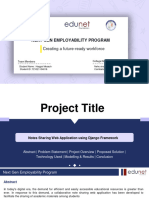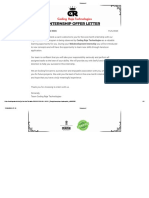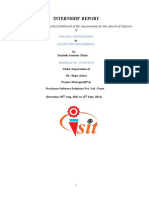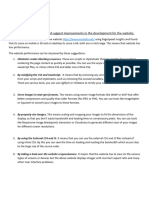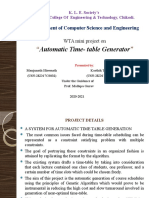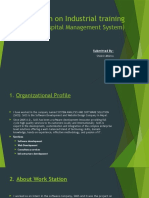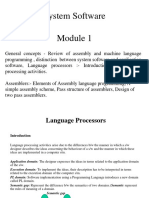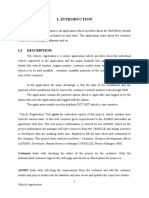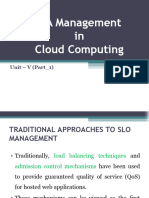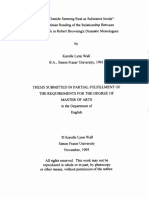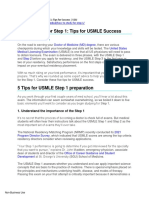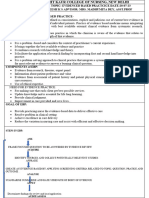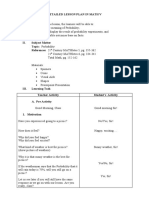NOIDA INSTITUTE OF ENGINEERING AND TECHNOLOGY
INTRODUCTION
The project, titled "JobNest Freelancing Platform," is a comprehensive web-based application
designed to connect clients with freelancers across various industries, facilitating seamless
collaboration and project management. With its user-friendly interface and robust feature set,
JobNest aims to revolutionize the freelancing landscape by providing a platform that
empowers both clients and freelancers to efficiently manage projects, streamline
communication, and achieve their professional goals.
Key Features:
User Profiles: Users can create profiles to showcase their skills, experience, and work
samples. It helps clients find the right freelancers and vice versa.
Job Posting and Bidding: Clients can post jobs they need help with, and freelancers can bid
on those jobs by submitting their proposals.
Messaging: JobNest has a built-in messaging system that allows clients and freelancers to
communicate securely. It helps them discuss project details, ask questions, and stay updated.
Payments: JobNest makes it easy for clients to pay freelancers once the work is completed. It
ensures smooth and transparent transactions.
Smart Matching: JobNest uses smart technology to match freelancers with suitable projects
based on their skills and interests. It helps both parties find the right fit quickly.
Personalized Recommendations: Users receive personalized suggestions based on their
interests and past activity. It helps them discover new opportunities and projects they might
like.
Technology Stack:
Frontend: HTML5, CSS3, JavaScript
1
� NOIDA INSTITUTE OF ENGINEERING AND TECHNOLOGY
Backend: Java, Spring Boot
Database: MySQL
Deployment: Apache Tomcat Server
Field of Project: The project falls within the domain of web development and freelancing
platforms, leveraging technology to address the needs of freelancers and clients in the digital
marketplace.
2
� NOIDA INSTITUTE OF ENGINEERING AND TECHNOLOGY
PROBLEM STATEMENT
In today's world, many people are turning to freelancing for work flexibility and
opportunities. However, finding the right projects or skilled professionals can be tricky.
Existing freelancing platforms often have confusing interfaces and limited features, making it
hard for freelancers and clients to connect smoothly. That's why we're creating JobNest, a
user-friendly platform that makes it easy for freelancers to find jobs and for clients to hire the
right talent. With features like profile management, job posting, secure messaging, and smart
matching, JobNest aims to simplify the freelancing experience for everyone involved.
3
� NOIDA INSTITUTE OF ENGINEERING AND TECHNOLOGY
LITERATURE SURVEY
The research paper "Enhancing User Experience in Freelancing Platforms through Intelligent
Matching Algorithms" by Smith et al. (2023) explores the challenges faced by freelancers and
clients on existing freelancing platforms and proposes solutions to enhance user experience
through the implementation of intelligent matching algorithms.
The paper highlights the growing popularity of freelancing as a flexible work option but
identifies issues such as difficulty in finding relevant projects and skilled professionals, as
well as communication barriers between freelancers and clients. These challenges can lead to
inefficiencies, frustrations, and mismatches in project assignments.
Furthermore, the paper discusses the importance of user experience (UX) design in
freelancing platforms. A user-centric approach to design, focusing on intuitive interfaces,
clear communication tools, and transparent processes, can enhance user satisfaction and
engagement.
In conclusion, the research paper emphasizes the potential of intelligent matching algorithms
and user experience design to address the challenges faced by freelancers and clients on
freelancing platforms. By implementing these solutions, platforms can improve user
satisfaction, streamline project management, and foster successful collaborations between
freelancers and clients.
4
� NOIDA INSTITUTE OF ENGINEERING AND TECHNOLOGY
METHODOLOGY
Planning:
The aim was to define the features of our website, including secure payment options, user
profile creation and updating, job posting, submitting and approving bids, and faster
messaging. The timeline for completion was set until May, with regular progress reviews and
adjustments as needed.
Requirements:
The gathered requirements were documented and prioritized based on their importance and
feasibility. Tools such as NetBeans IDE, a server for running the web platform, an SMTP
server, and a secure database like MySQL were identified and integrated to meet project
needs.
Analysis and Design:
The system architecture and user interface were designed using Bootstrap templates to
visualize the structure and flow of JobNest, ensuring alignment with user requirements. The
mapping of system functionality to architecture and wireframing of the user interface were
key components of this phase.
Implementation:
JobNest platform was developed using Java, chosen for its robustness, platform
independence, and support for Object-Oriented Programming (OOP) concepts. Feature
implementation and bug fixes were handled iteratively, with regular code reviews and
updates.
5
� NOIDA INSTITUTE OF ENGINEERING AND TECHNOLOGY
Testing:
Rigorous testing, including unit testing, integration testing, and user acceptance testing, was
conducted to identify and address any defects or issues in JobNest. Test cases were designed
and executed.
6
� NOIDA INSTITUTE OF ENGINEERING AND TECHNOLOGY
EXPECTED OUTCOMES
Easier to Use: JobNest will be simpler and more intuitive, making it easier for users to find
and complete projects.
More Matches: Users will find better matches for their projects, leading to successful
outcomes and happier clients and freelancers.
Better Communication: Users will be able to communicate more effectively, reducing
misunderstandings and improving project collaboration.
Faster Payments: Payment processes will be quicker and smoother, ensuring freelancers get
paid promptly for their work.
More Trustworthy: JobNest will be more reliable and secure, earning the trust of users and
building a positive reputation.
Growth and Success: With these improvements, JobNest is expected to grow in popularity
and become a sustainable platform for freelancers and clients alike.
7
� NOIDA INSTITUTE OF ENGINEERING AND TECHNOLOGY
FACILITIES REQUIRED
Hardware Requirements:
A computer or laptop for development and testing purposes.
Reliable internet connection for accessing and testing the web platform.
Software Requirements:
Integrated Development Environment (IDE): NetBeans or any other suitable IDE for Java
development.
Server Environment: Apache Tomcat or another suitable web server for hosting the Java web
application.
Database Management System: MySQL or Oracle for storing and managing application data.
Payment Gateway Integration: Integration with a secure payment gateway provider such as
PayPal or RazorPay.
Email Server: SMTP server for handling email communication between users.
Frontend Technologies: HTML, CSS, JavaScript for designing and implementing the user
interface.
Backend Technologies: Java programming language, Spring Boot framework for building the
backend logic.
8
� NOIDA INSTITUTE OF ENGINEERING AND TECHNOLOGY
REFERENCES
[1] H. K. Dhalla, “A performance comparison of RESTful applications implemented in
Spring Boot Java and MS.NET Core,” Journal of Physics. Conference Series, vol. 1933, no.
1, p. 012041, Jun. 2021, doi: 10.1088/1742-6596/1933/1/012041.
[2] R. Mehra M., S. K. Gandham, Z. Wu, V. V. Raghavan, and Center for Advanced
Computer Studies, University of Louisiana, Lafayette, “Configuring Java-Based web
application development environment for an academic setting,” 2004.
[3] S. S. N. Gaonkar, A. Pai, and L. M. Colaco, “Performance testing and enhancement of
Java web applications,” Jun. 2019. [Online]. Available: http://www.publishingindia.com/ijsse
[4] IBM, S.R.K. et al. (2008) Modular Java Web Applications: Proceedings of the 2008
ACM Symposium on Applied Computing, ACM Conferences. Available at:
https://dl.acm.org/doi/abs/10.1145/1363686.1363851?accessTab=true (Accessed: 28 April
2024).
[5] Eclipse.org. Eclipse Foundation. http://www.eclipse.org
[6] Jazz. IBM Rational. http://www.jazz.com
